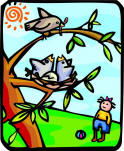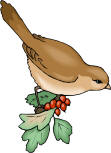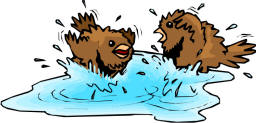Creating a Bird-Friendly Yard - Landscaping for Birds

The habitat you provide in your yard will influence the number and types of birds that you attract. You can attract birds by adding bird feeders, nest boxes, and bird baths to your yard. You can also attract birds by planting a variety of plants, flowers, trees, and shrubs. Appropriately selected plantings can provide nesting sites, winter shelter, protection from predators, and natural food sources.
A backyard habitat landscaping plan can increase the number of wildlife species you will find in your yard, while providing a beautiful yard for you to enjoy.
Plants for Food and Cover: Different birds have different food requirements. Learn the food preferences of the birds you want to attract to your yard and select your plantings accordingly from the table provided.
View a list of plants for the bird-friendly landscape
Bird Friendly Landscaping Tips

Create a highway for the birds: Create corridors for birds to travel through by connecting planting areas in your yard with planted areas in your neighbors' yards. Plant in masses instead of scattering single plants around the yard.
Mix it up: Plant vegetation in a variety of types and heights. This will be most like a natural habitat. Mix trees, large shrubs, small shrubs, perennials, and groundcovers throughout your yard.
Plant living fences: Use natural shrub borders instead of fences. The shrubs will be attractive landscape features and will provide food, shelter, and nesting areas for birds.
Let it Be: Try to resist the urge to clean up every little corner of your yard or garden. Leaving leaf litter gives birds a place to forage for insects. Leaving the dried seed heads on flower stalks provides food for the birds and, in many cases, allows plants to naturally re-seed for next year's crop. Leaving a few areas of your yard or garden to grow a little tall and wild provides welcomed food and shelter for your feathered friends.
A Prickly Situation: Consider including some plants with thorns or prickly leaves in your landscape. These thorny plants provide excellent nesting areas for birds. The thorns keep them safe from predators. Pyracantha (fire thorn) and holly are good examples, which also provide berries for food. Plant these near the edge of your property or in a less frequented area, to avoid getting scratched up yourself.
Evergreen Shelter: Evergreen trees and shrubs provide nesting for birds during the warm weather and protected roosting sites during the cold of winter. Evergreens come in a variety of shapes and sizes, and you should be able to find one or two suitable to any yard. Choose from firs, spruces, pines, junipers, hemlocks, and hollies.
Plants that provide good bird habitat: The following is a generalized list of plants that attract birds for food and shelter:

Bayberry, blackberry, beech, birch trees, cherries, dogwoods, elderberry, fir trees, hackberry, hickory, holly, maple, mountain ash, oak, pines, red cedar, red mulberry, serviceberry, spruce, viburnum shrubs, sumac, Virginia creeper, wax myrtle shrubs, wild strawberry, winterberry.
Share your produce: Many of the fruits and berries we plant for ourselves are also enjoyed by birds. Rather than trying to keep the birds out of your strawberries, blueberries, and fruit trees, consider planting more than you need for yourself. That way, there should be enough fruit for you and the birds.
Backyard Wildlife Habitat
Design a wildlife friendly backyard and receive Backyard Wildlife Habitat Certification from the National Wildlife Federation.
Bird Baths
Birds will bathe in and drink from just about anything that will hold water, including puddles on the ground and clogged up rain gutters on your house.

The Well Designed Bird Bath: The ideal bird bath has a basin with graduated depths, with the water only about 1/2 inch deep at the edges and no more than 3 inches deep in the center. The bottom of the basin should not be too slippery. In cold climates, the birdbath should be made of a materials that will resist cracking if the water freezes.
Provide a place for birds to escape predators and to dry off: Wet birds don't fly very well. They need a place near the bath on which they can safely perch and dry their feathers. Good size shade trees are ideal for this purpose.
Resources for Creating a Bird-Friendly Landscape
Guidance from the Cornell Lab of Ornithology
For east coast property owners
